Classroom Storytelling: Time to Play Again!
A MiddleWeb Blog
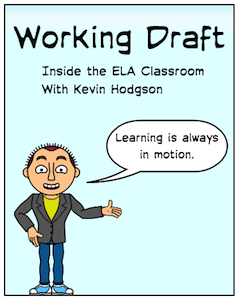
In the small valley in Western Massachusetts where I live and teach, there are many, many professional storytellers. Almost as many as musicians, and if you lived in our valley, you’d know what I was talking about (there are a lot of musical groups and venues here).
One of the more prominent storytellers is a gentleman named Tom McCabe, whose irreverent and humorous Paintbox Theater productions have been a source of theatrical entertainment for my sons and me for many summers counting.
Tom also regularly visits schools to work with students and teachers on storytelling and literacy. However, he’s most famous to the young crowd in these parts for his shoes.
What began as a young girl’s gift of a friendship pin that Tom attached to his footwear has now become a veritable menagerie of buttons, pins and assorted presents from other children that crinkle and tinkle as he walks. Tom’s shoes are legendary.
In December, Tom came to our church to guide the annual children’s Christmas Pageant. To say it was a break from the past would be a bit of an understatement.
Tom led the kids in a relatively unscripted and totally unrehearsed story of Joseph and Mary’s travels to Bethlehem, as told by a television reporter (Tom) interviewing people, animals and celestial stars (the kids) in the fields, on the road and in the sky.
I was struck at how natural Tom was at this weaving of a story, and how not only the stories flowed from him seamlessly but how his words invited the young actors to be part of the tale.
Storytelling is a playful art
Tom’s prowess was on my mind as I was reading through a new book by Kevin Cordi about the art of storytelling, and how to bring its oral tradition and playfulness back into our classrooms in this day of standardized testing, aligned scope and sequence, and Common Core shifts.
Cordi’s book – Playing With Stories: Story Crafting for Storytellers, Writers, Teachers and other Imaginative Thinkers – is packed with his experiences as a full-time storyteller and educator who has worked with schools and organizations around the country to celebrate our collective stories and diverse cultural heritage – and to nurture our imaginations and enrich our knowledge.
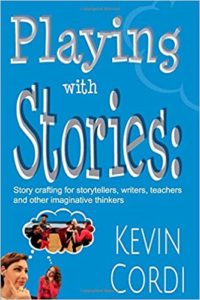
Cordi’s definition of play extends beyond just having fun. It has to do with playing a story out in many directions to find its possibilities along the various tangents, to open up a tale to something new.
Cordi does this through a series of exercises, rooted in drama and theater, that ask probing questions and lead to student storytelling activities. Play pushes the storyteller to reconsider the story in new light. (Visit Cordi’s blog for more storytelling insights.)
Do we play enough?
As Cordi, a former high school teacher and now university professor and a co-director of the Columbus Area Writing Project, notes:
“There should be more play in the classroom … Our educational system, driven by standards and mandates, is more concerned with outcomes than development.
“This was most felt in the nationwide and statewide efforts to standardize learning. I watched the creative vein drain from some of my colleagues as we pushed out creative methods that helped our students to learn.” (p. 17)
His words had me mulling over my own classroom practice. Do we play enough in my room? Do we play with stories? We do play with technology – I always allocate time for students to play around and explore before launching into a project. Make mistakes. Find workarounds. Push against the limits.
But do we really play with writing on a regular basis, so that that exploration is part of our writing and learning environment?
I’m sad to say, I’m not so sure.
Some things we’ve lost

Dr. Kevin Cordi
Cordi’s words reminded me of a storytelling activity I used to do with my sixth graders on a regular basis. They were given a card with five objects listed on it, and their task was to orally tell a story, weaving in some of the objects before passing the story to the next student, who would continue the story with some of the objects on their card, and so on. It was fun and it helped situate brainstorming and on-the-spot storytelling for our writing projects.
I don’t do that activity anymore.
We also used to do a koosh ball storytelling activity. Start a story, pass the ball to someone else, and then they have to tell the next part of the story, and then they pass the ball along to someone else … and so on.
We don’t do that one anymore, either.
I also eliminated our puppet theater project, which used to engage my students from Thanksgiving to December break with script writing, puppet making and performances for younger students in our school.
Faced with data from our testing that showed some significant areas of weakness around open response writing, I started to question the amount of time it was taking to play with puppets. As the Common Core mandates came barreling down on me even harder, I decided something had to give. The puppets went.
I still regret that necessity when November rolls around (although we now do a video game design project during that time, so maybe it was a wash). For sure, when we stopped the puppet project we sucked a bit more collaborative play out of the classroom.
Bringing back play and storytelling
What happened to the playfulness of our storytelling? More important, how do I bring it back to my classroom?
If anything, we need more, not fewer, storytellers to make sense of the world. Even corporations now understand that selling products is really about selling a story (see Mad Men for evidence). Politicians weave stories to tell the voters who they are and what they stand for.
In our professional and personal networks, we make connections and bonds by sharing our stories. We develop empathy and understanding. We live in our stories as we share out our stories.
There is plenty in Cordi’s book for teachers to pull from. He gives a range of ways we can use engaging stories as literacy practice, laying bare the craft of the storyteller.
A Kevin Cordi storytelling session
One of the messages that resonated with me is that there is no “one way” to tell a story, although we often have students write a story from start to middle to ending. His invitation to “play the story” and do what he calls “word dancing” with language is a welcome one, too, and is not nearly as at odds with the educational standards of the day as it might seem.
After all, the speaking and listening standards of the Common Core rise up to be front and center with writing and reading. And if storytelling, and the exploration of the power of voice and narrative, don’t open the door for that kind of learning environment, then I don’t know what will.
Cordi even shares a project in which he worked with students on an anti-bullying storytelling campaign called Our Stories Count as a way to counter the turmoil of social negativity. That’s playing with stories with a purpose.
Cordi ends his book with something he calls his Permission 2 Play Pledge (p.152), which I think deserves a space on our classroom walls (and perhaps our hearts as well). It surely deserves a place here in this column.
Permission 2 Play Pledge
I give myself permission
To have fun.
To take risks.
To make mistakes.
To Play
with my thinking
my choices
my direction and development,
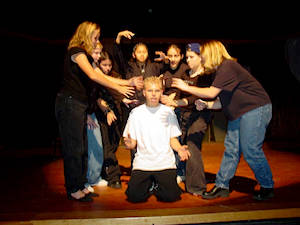
what I know
so
I know more
I give myself
permission
to
fail, succeed, and play again.
I have the right to shape
my stories.
I am the crafter and creator.
I am imaginative and supportive.

play
we understand our stories
and our stories become
alive
I give myself
permission to Play.
I do. I will. How about you?
Image credits:
Tom McCabe – The Longmeadow News.
Other photos – Kevin Cordi
Also see:
Mary Langer Thompson’s review of Playing with Stories

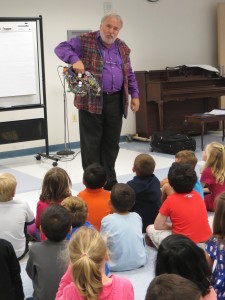
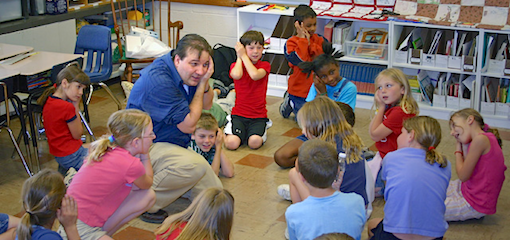


































This is great Kevin. I can’t wait to read this book!